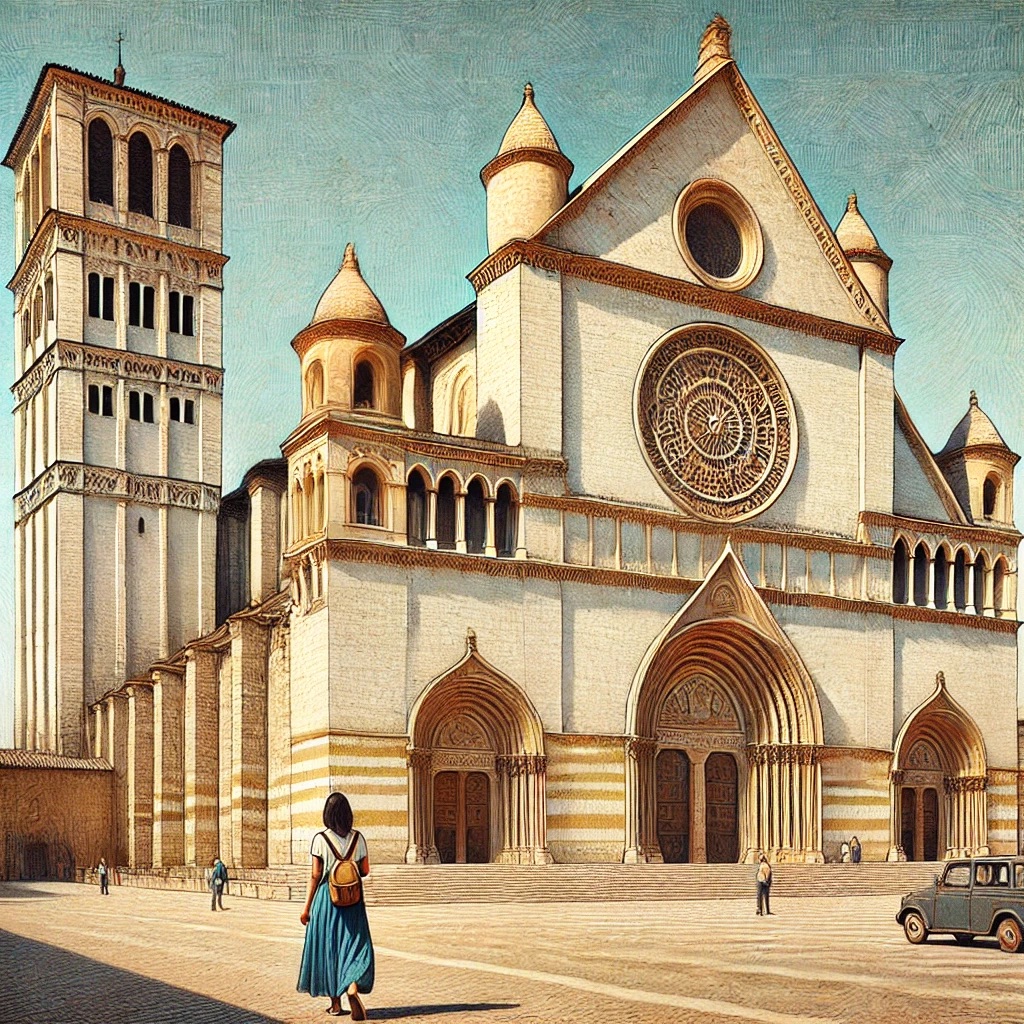ChatGPT:Assisi is a historic town in the Umbria region of Italy, known for its medieval architecture, significant religious sites, and picturesque landscapes. It is famously the birthplace of St. Francis of Assisi, the founder of the Franciscan Order, and St. Clare, the founder of the Poor Clares.
Assisi’s narrow winding streets, stone houses, and scenic vistas contribute to its charm, making it a popular destination for tourists seeking both spiritual and cultural enrichment.
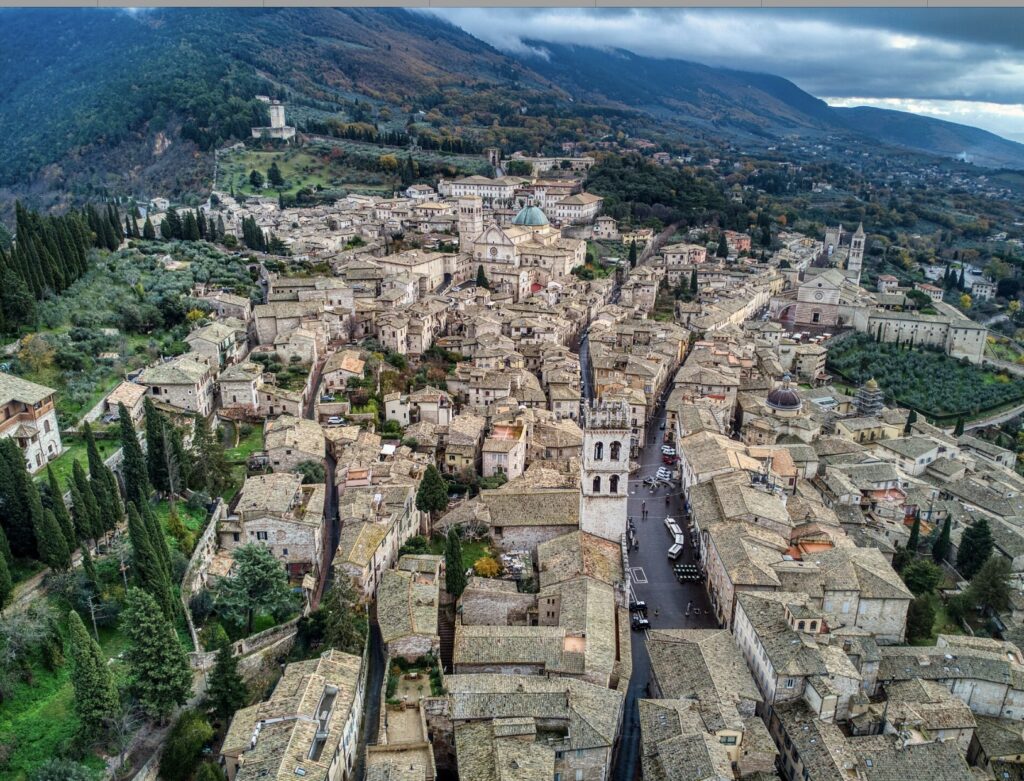
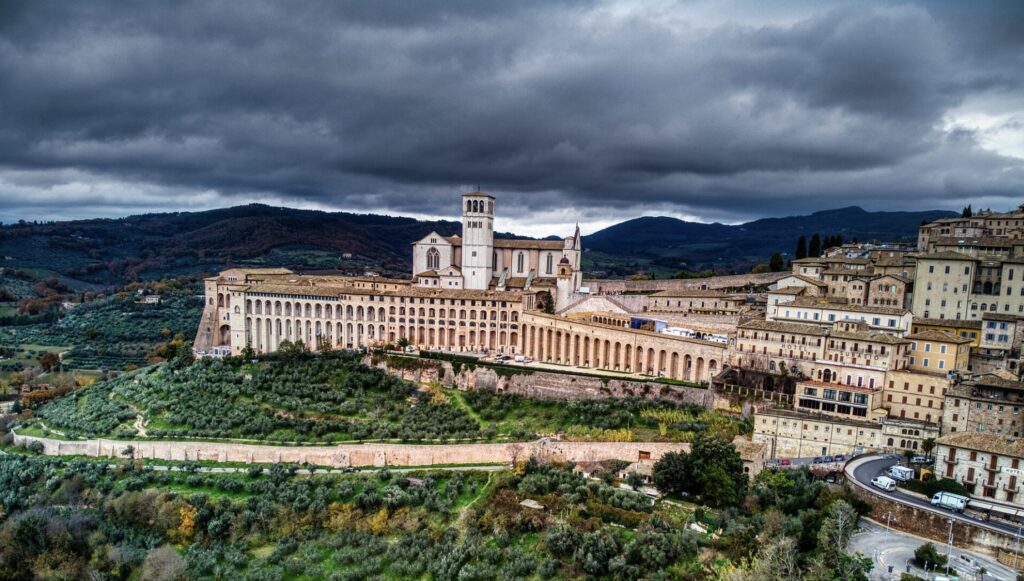
Assisi’s origin, history, and development span several millennia, marked by various cultural influences and significant historical events.
Origin and Early History
- Pre-Roman Period: Assisi was originally inhabited by the Umbrians, an ancient Italic people. The settlement was known as Asisium.
- Roman Era: Assisi became a Roman municipium around 295 BCE. The Romans developed the town with typical infrastructure, including the forum, amphitheater, and the Temple of Minerva. Remnants of these structures are still visible today.
Medieval Period
- Early Middle Ages: After the fall of the Roman Empire, Assisi experienced a period of turmoil, including invasions by the Ostrogoths and Lombards.
- 10th-12th Centuries: The town grew in importance and became a free commune. It developed its own government and minted its own coins.
- St. Francis of Assisi (1181/1182-1226): The birth of St. Francis brought immense religious significance to the town. His life and works, along with those of St. Clare, who founded the Poor Clares, marked Assisi as a center of spiritual renewal.
Renaissance to Modern Era
- 14th-16th Centuries: Assisi continued to develop architecturally and artistically, with the construction of the Basilica of San Francesco and other religious buildings.
- Napoleonic Wars: Like many Italian towns, Assisi was affected by the Napoleonic Wars, experiencing political and social changes.
- 19th Century: With the unification of Italy, Assisi became part of the newly established Kingdom of Italy.
20th Century to Present
- World Wars: Assisi largely escaped destruction during the World Wars, allowing its historical sites to remain intact.
- Modern Development: Today, Assisi is a UNESCO World Heritage site and a major tourist destination. The town has preserved its medieval character while integrating modern amenities to support tourism and local life.
Cultural and Religious Significance
- Pilgrimage Site: Assisi’s connection to St. Francis has made it a major pilgrimage site for Christians worldwide.
- Art and Architecture: The town is renowned for its medieval architecture and significant artworks, particularly the frescoes in the Basilica of San Francesco.
Economic Development
- Tourism: Tourism is a vital part of Assisi’s economy, driven by its religious significance, historical sites, and cultural events.
- Local Products: Assisi is also known for local crafts, food products, and wines, which contribute to the local economy.
Assisi’s rich history and development reflect a blend of ancient traditions, religious significance, and modern adaptation, making it a unique and enduring town in Italy’s cultural landscape.
Influence of St. Francis in Medieval Times
- Religious Reform and the Franciscan Order:
- Foundation: St. Francis founded the Franciscan Order in 1209, emphasizing vows of poverty, humility, and service to the poor and sick. His approach was a radical departure from the wealth and power associated with the Church at the time.
- Growth: The order grew rapidly, attracting many followers who were inspired by St. Francis’s example and message. The Franciscans became influential in spreading these ideals across Europe.
- Social Impact:
- Care for the Poor: St. Francis’s dedication to the poor led to the establishment of numerous hospitals, shelters, and charitable institutions.
- Peacemaking: He was known for his efforts to mediate conflicts, such as his meeting with Sultan Al-Kamil during the Fifth Crusade, which sought peaceful dialogue rather than conflict.
- Cultural and Artistic Influence:
- Art and Literature: St. Francis inspired many works of art and literature during the medieval period. The Basilica of San Francesco in Assisi, adorned with frescoes by Giotto and Cimabue, became a pilgrimage site and an artistic landmark.
- Environmental Awareness:
- Nature and Creation: St. Francis’s deep connection with nature and his view of all creatures as brothers and sisters led to a renewed appreciation of the natural world, reflected in his “Canticle of the Creatures.”
Influence of St. Francis in Modern Times
- Continued Religious Significance:
- Franciscan Order: The Franciscan Order remains one of the largest and most active religious orders within the Catholic Church, continuing St. Francis’s mission of poverty, humility, and service.
- Papal Influence: Pope Francis, elected in 2013, chose his papal name in honor of St. Francis, signaling his commitment to humility, care for the poor, and concern for the environment.
- Social and Humanitarian Efforts:
- Charitable Work: Modern Franciscans are involved in extensive humanitarian efforts, including education, healthcare, and social justice initiatives worldwide.
- Advocacy for Peace: Inspired by St. Francis’s example, the order and its followers continue to work towards peacemaking and conflict resolution.
- Cultural and Educational Influence:
- Education: Numerous educational institutions, including universities and schools, are named after St. Francis and promote his values.
- Arts and Media: St. Francis remains a popular subject in literature, film, and the arts, symbolizing simplicity, peace, and a profound connection to nature.
- Environmental Advocacy:
- Ecology and Sustainability: St. Francis is often regarded as the patron saint of ecology. His teachings inspire contemporary environmental movements and initiatives focused on sustainability and respect for nature.
- Laudato Si’: Pope Francis’s 2015 encyclical “Laudato Si'” emphasizes care for the environment, drawing heavily on St. Francis’s views on nature and creation.
St. Francis of Assisi’s legacy continues to shape religious thought, social practices, cultural expressions, and environmental advocacy, making his influence enduring and relevant in both medieval and modern contexts.
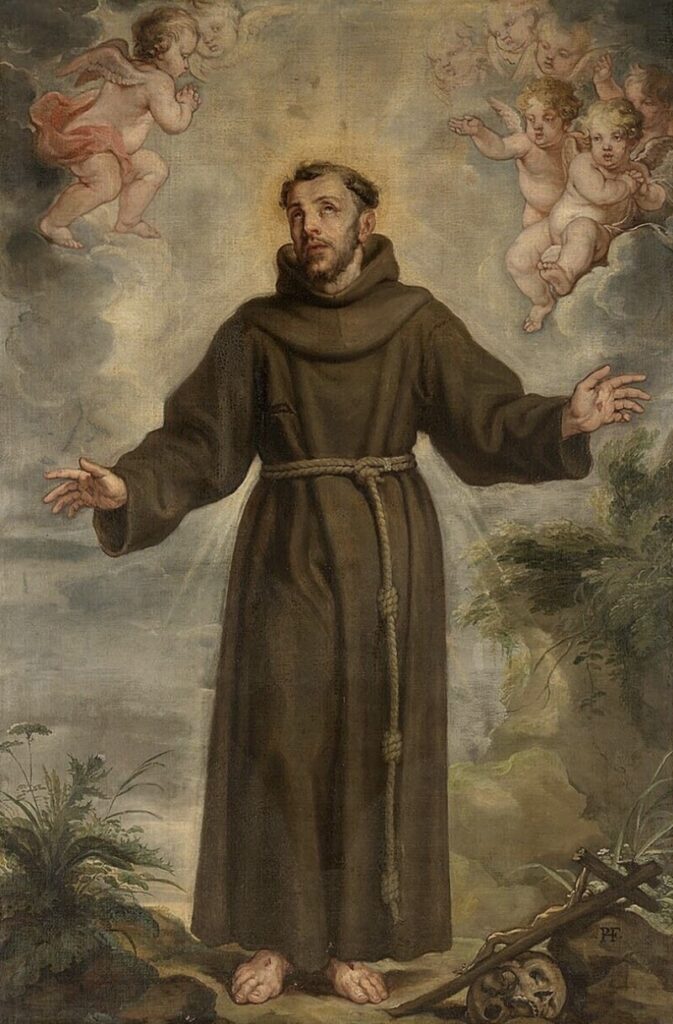
Historical Monuments and Tourist Attractions in Assisi
- Basilica of San Francesco d’Assisi (1228-1253):
- This UNESCO World Heritage site is the burial place of St. Francis and features magnificent frescoes by Giotto, Cimabue, and other artists.
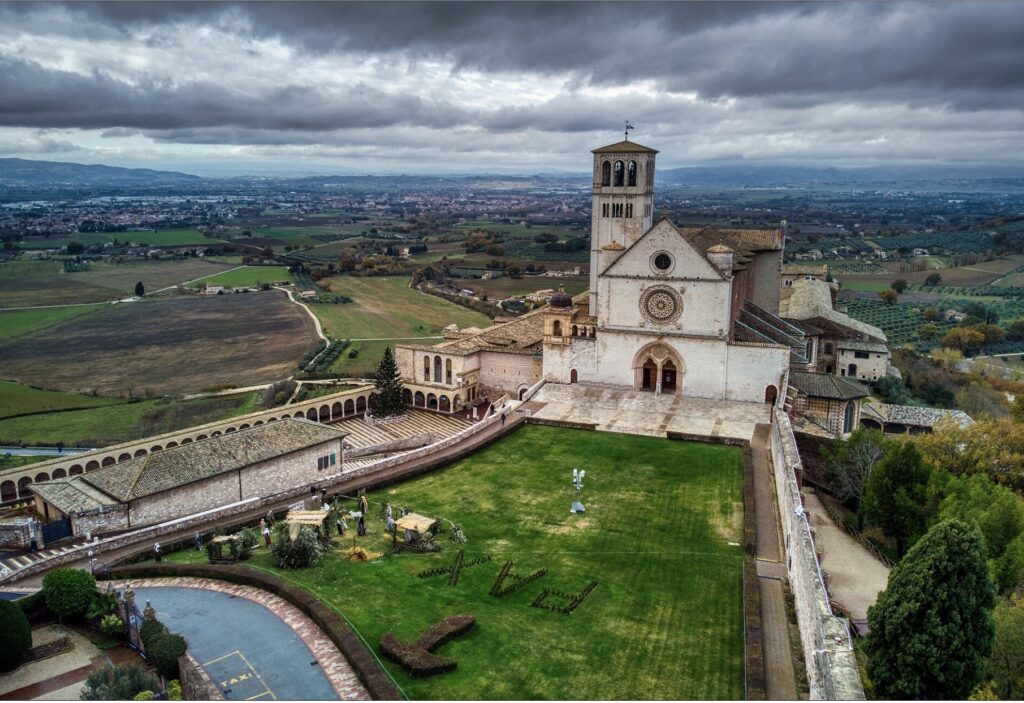
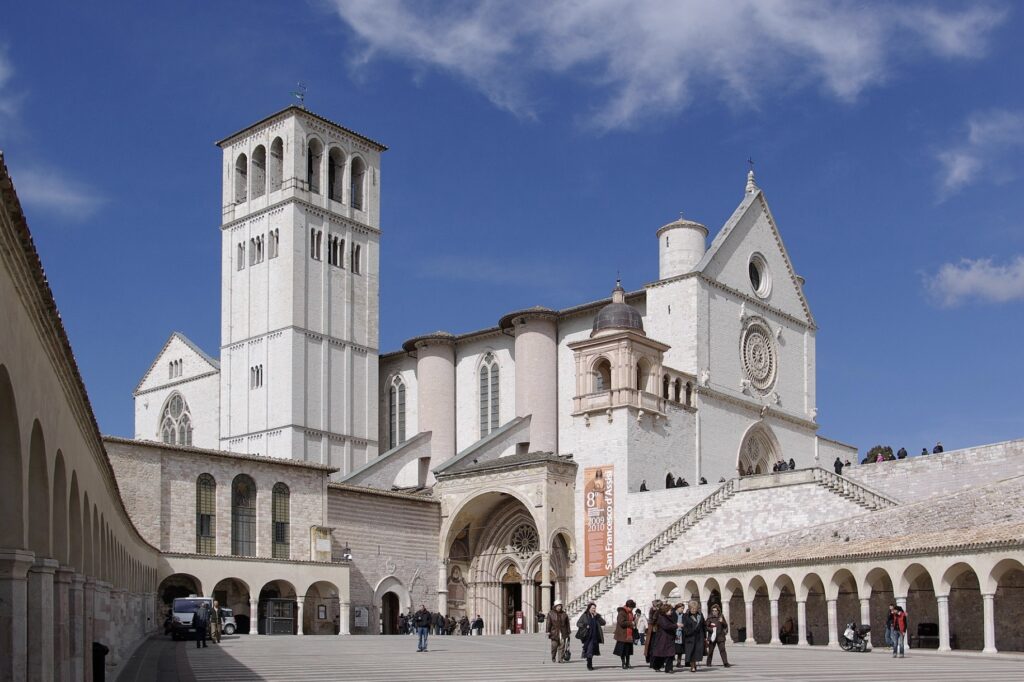
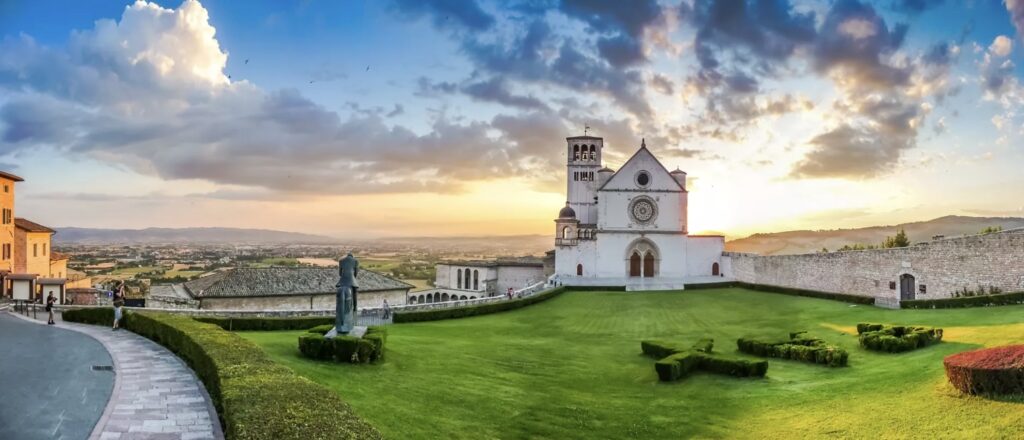
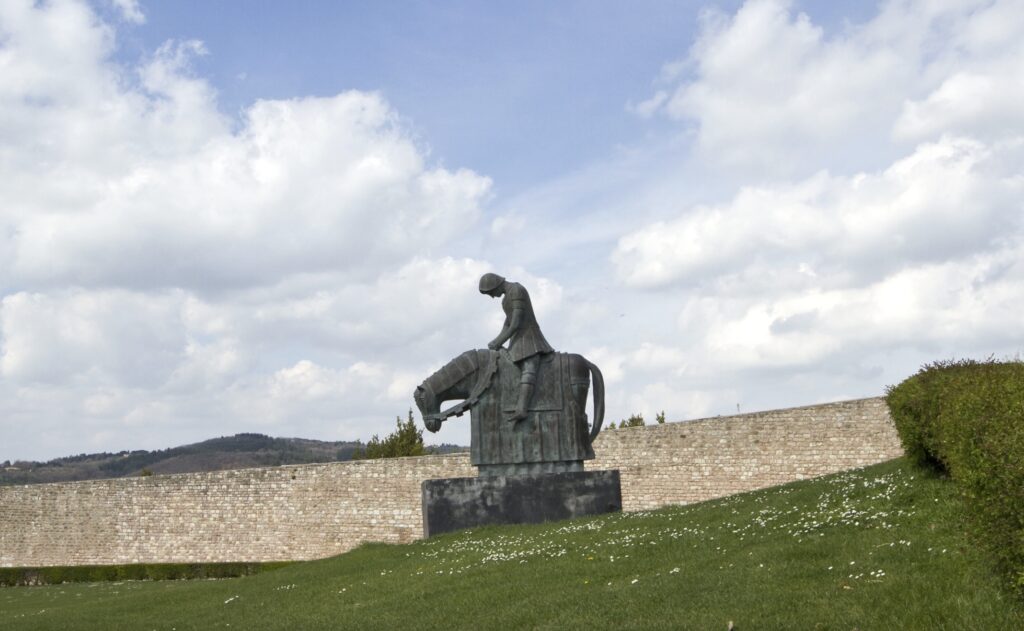
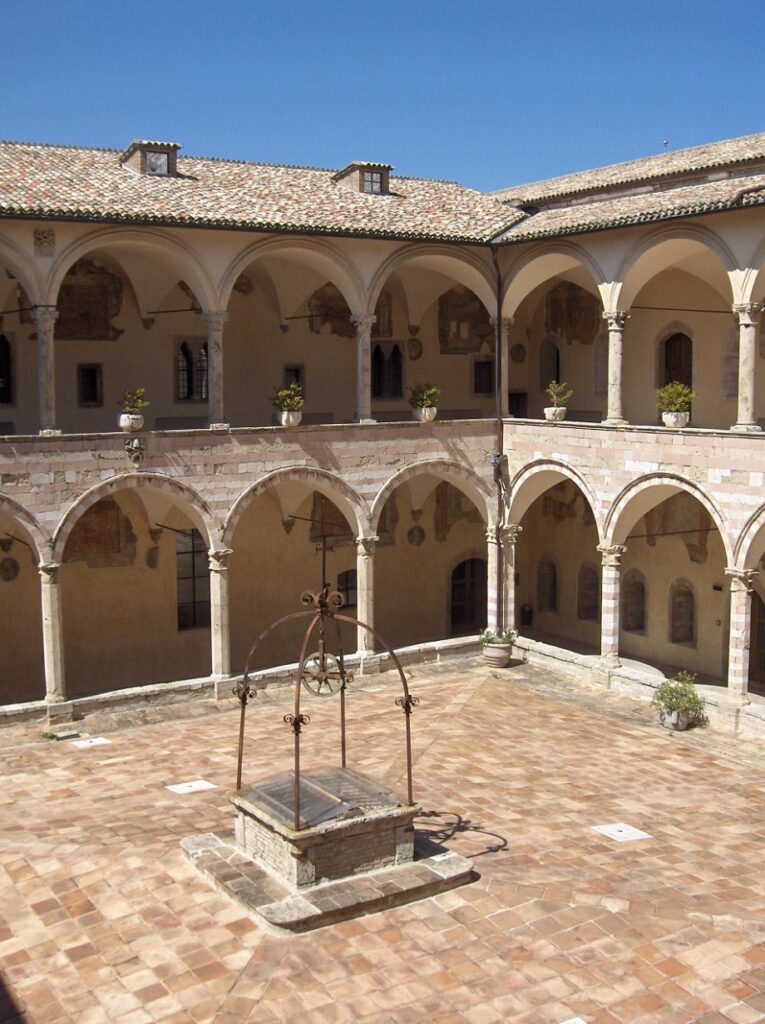
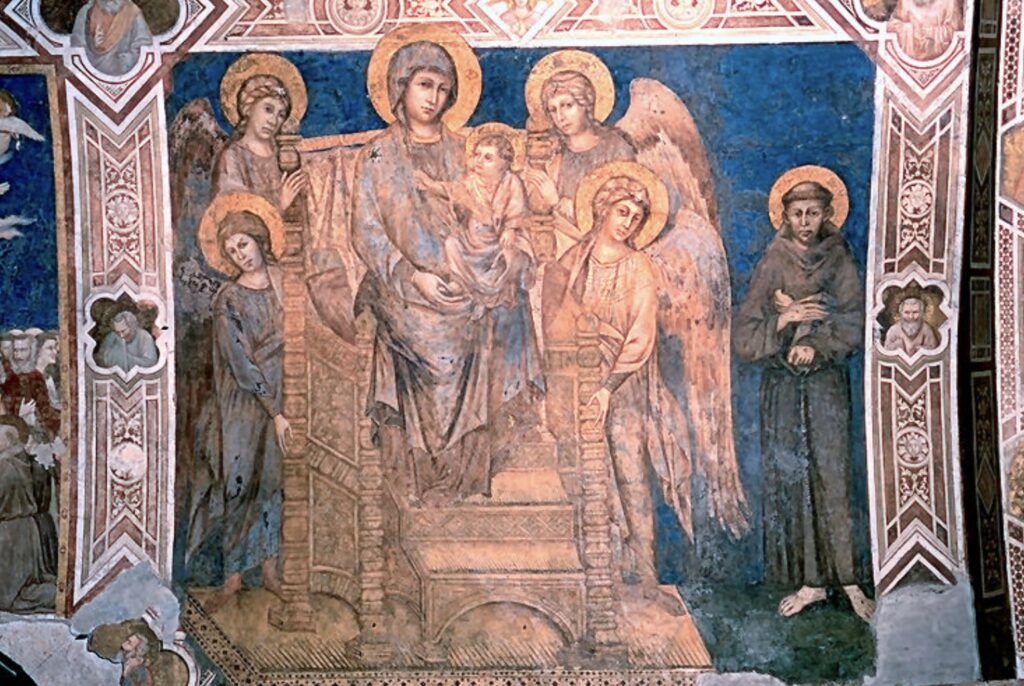
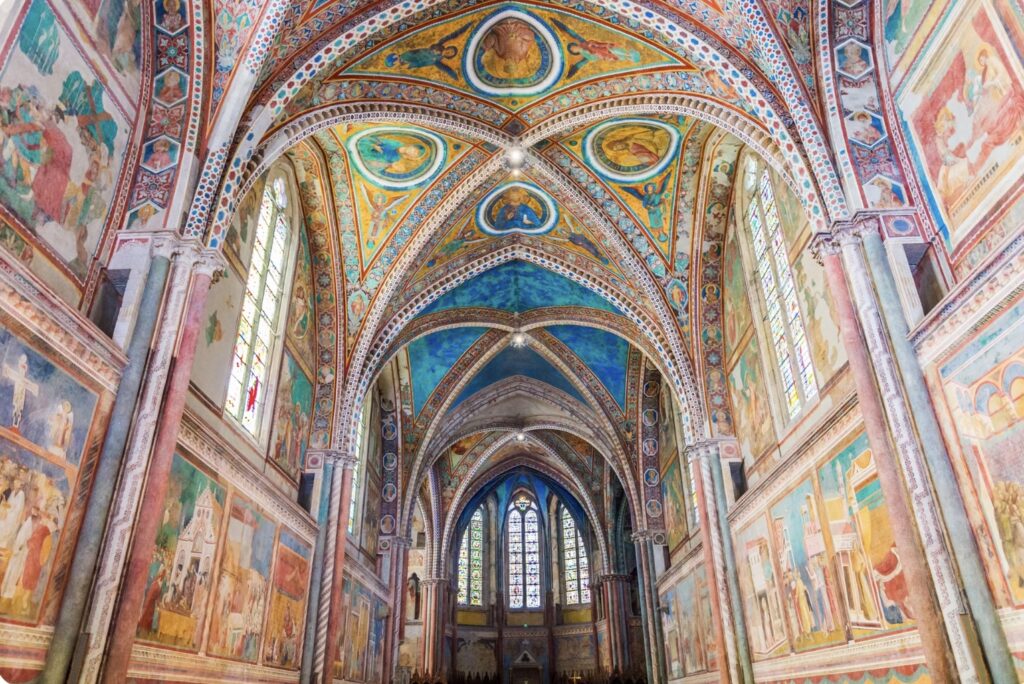
- Basilica of Santa Chiara (1257-1265):
- Dedicated to St. Clare, this Gothic-style church houses her tomb and the famous Crucifix of San Damiano.
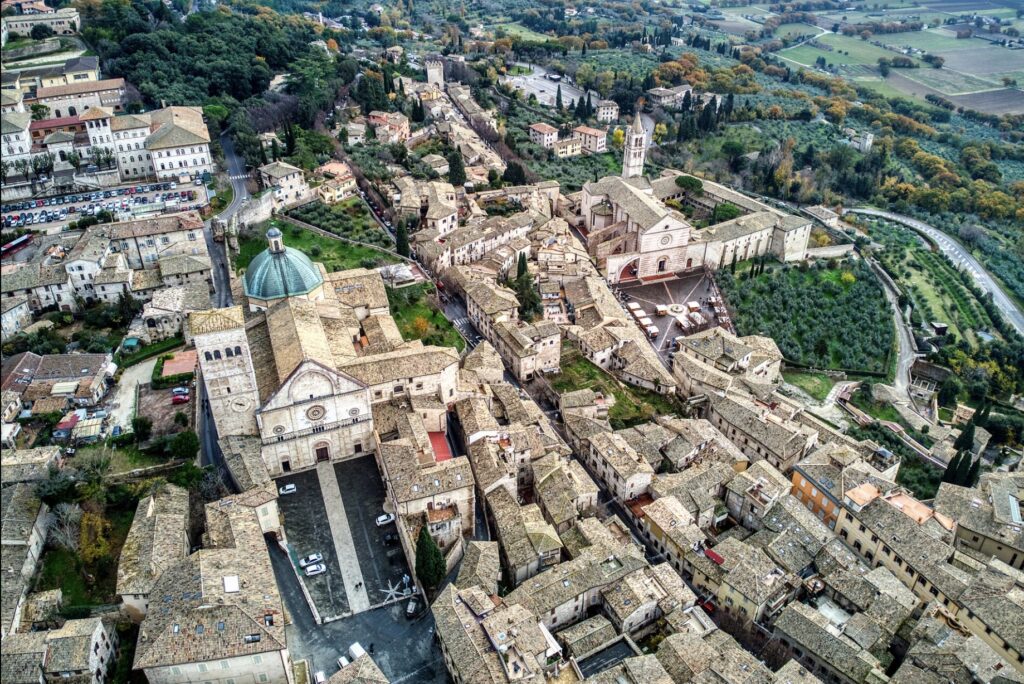
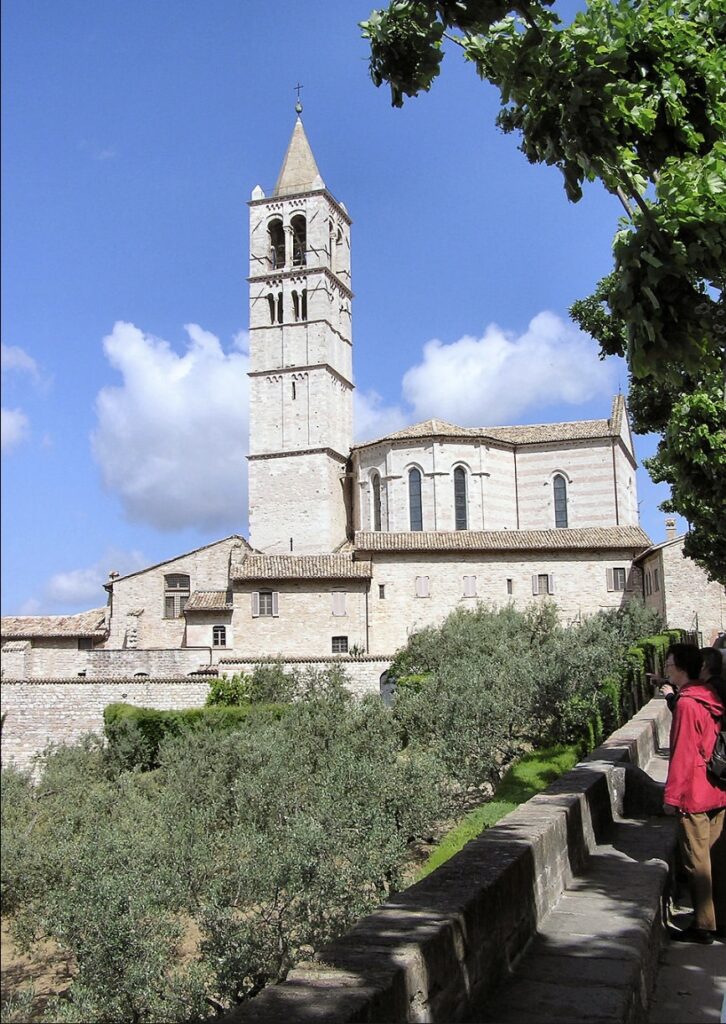
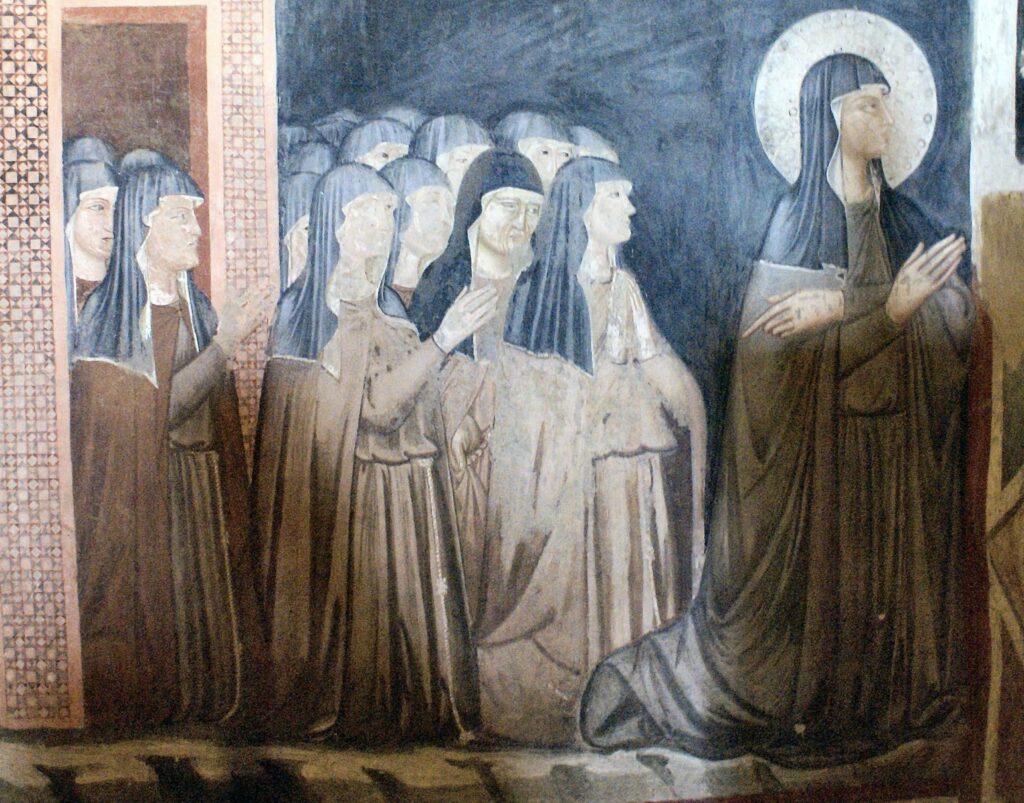
- Piazza del Comune (Roman Era, Medieval Development):
- The central square of Assisi, featuring the Temple of Minerva, a Roman temple dating from the 1st century BCE, and various medieval buildings
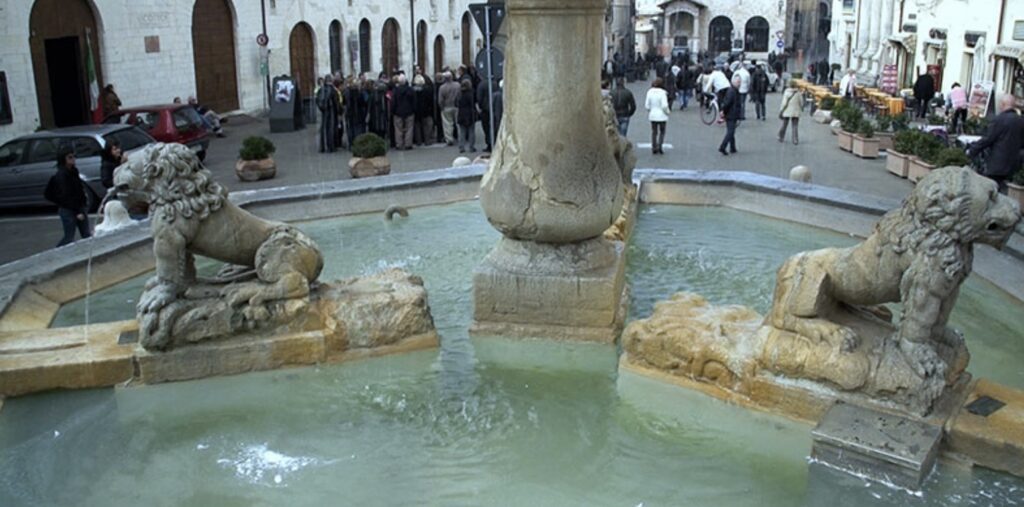
- Temple of Minerva (1st century BCE):
- A well-preserved Roman temple, now part of the Church of Santa Maria sopra Minerva.
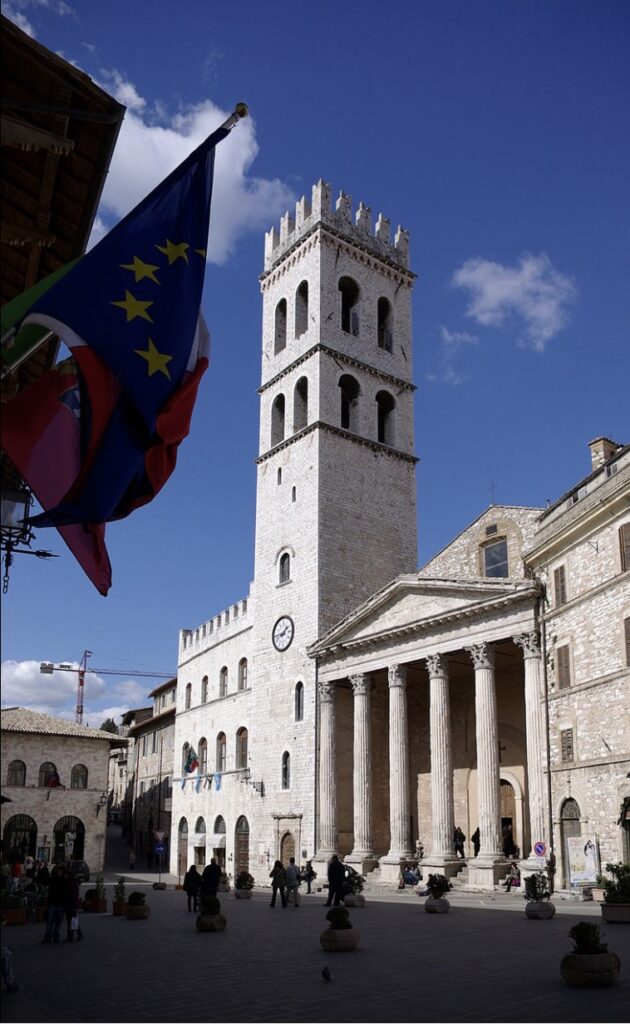
- Rocca Maggiore (12th century):
- A medieval fortress offering panoramic views of Assisi and the surrounding countryside. It was rebuilt in the 14th century.
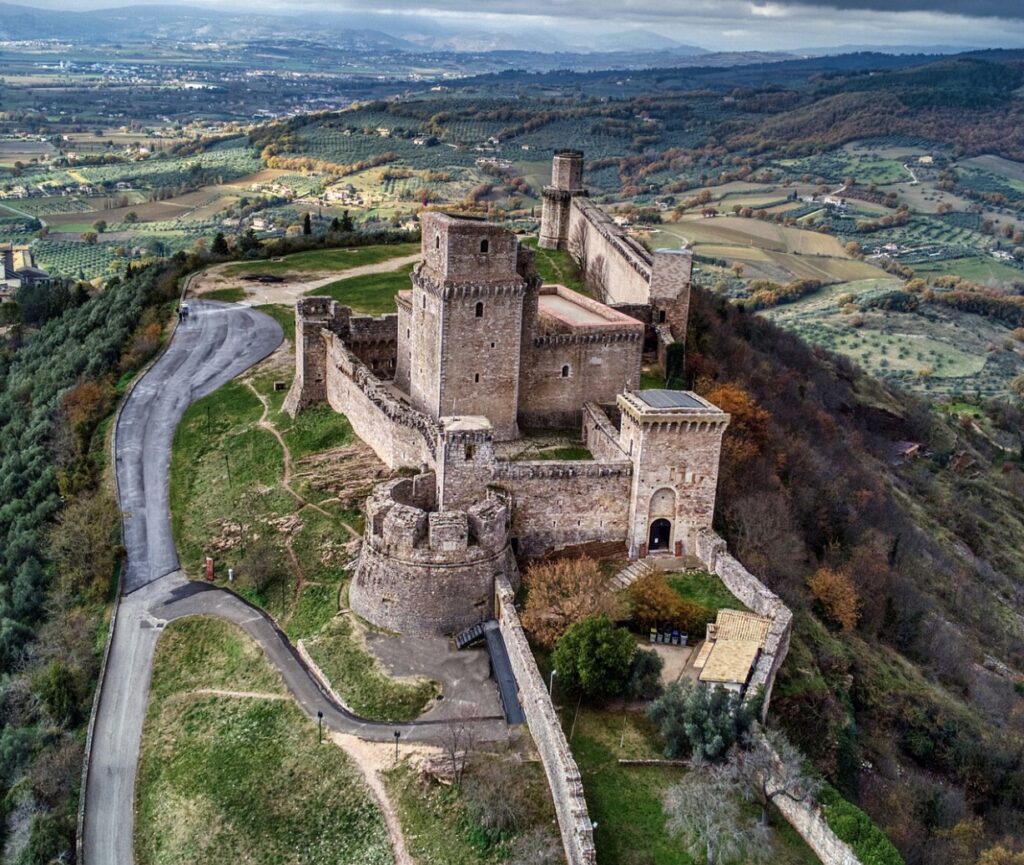
- San Damiano (12th century):
- The church where St. Francis is said to have received his calling and where St. Clare established the Poor Clares.
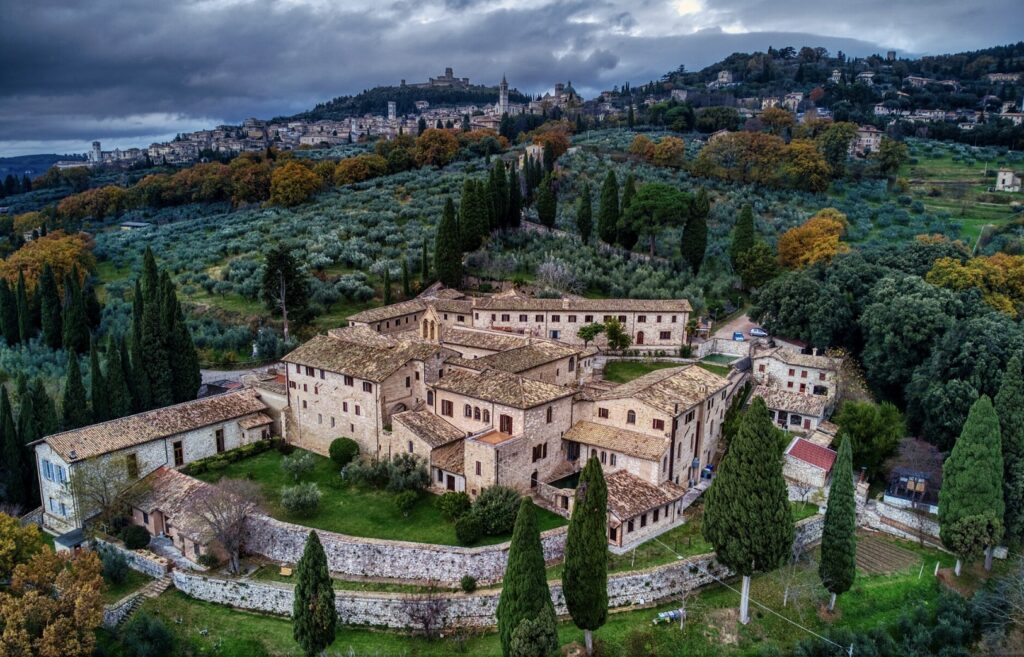
- Eremo delle Carceri (Hermitage, 13th century):
- A retreat in a forested area on Mount Subasio where St. Francis and his followers went for prayer and contemplation.
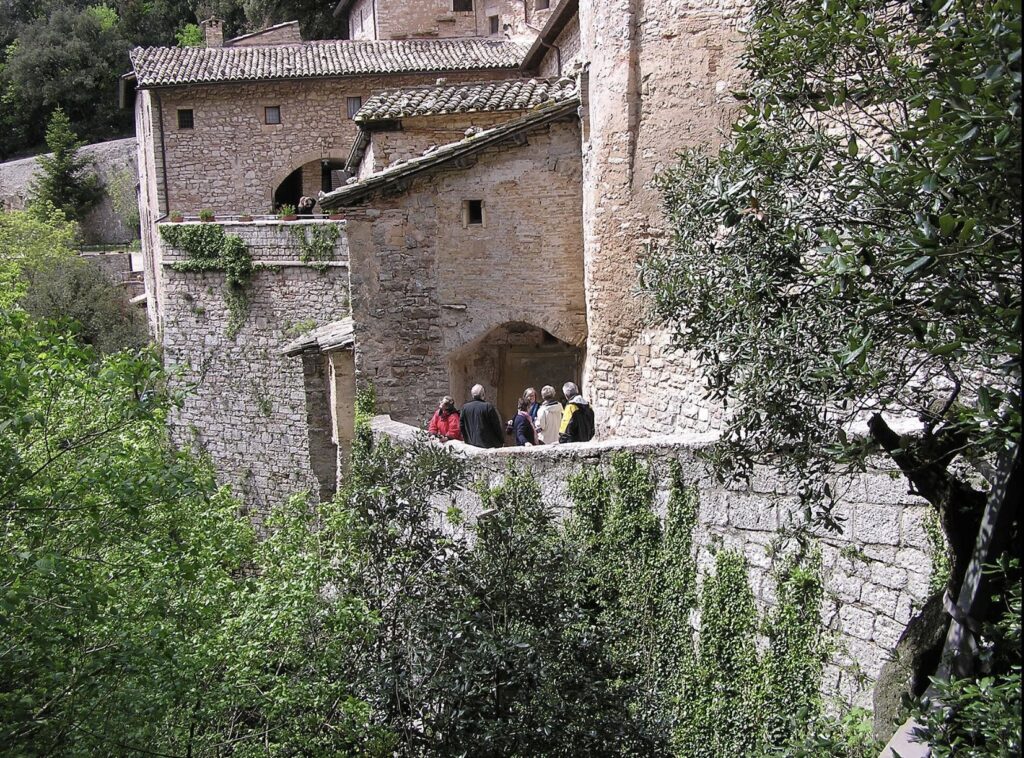
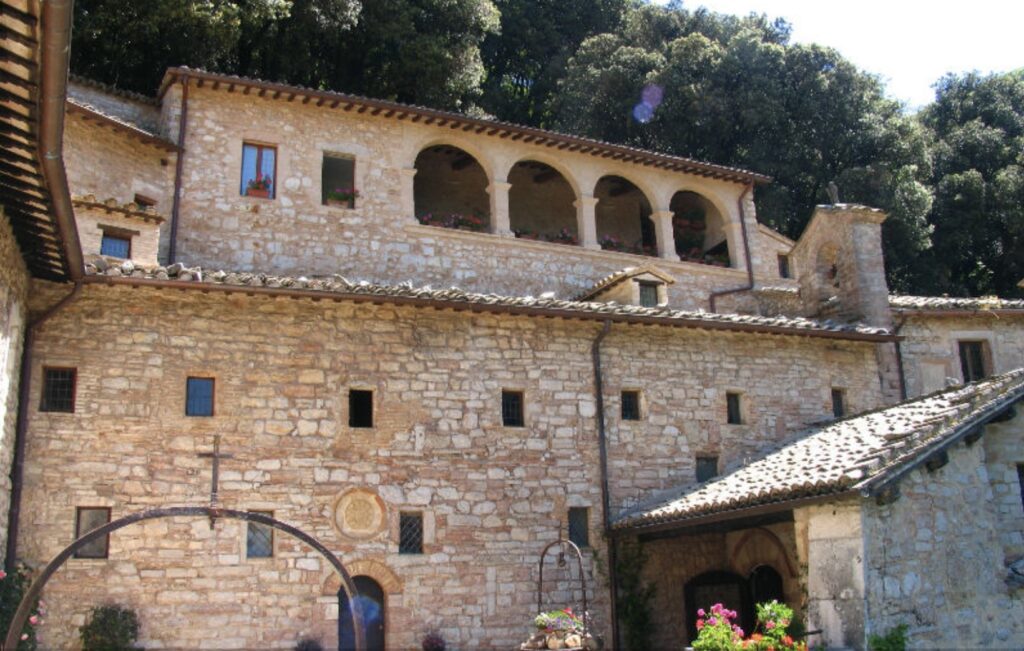
- Cathedral of San Rufino (12th century):
- The main church of Assisi, where St. Francis and St. Clare were baptized. It features a Romanesque façade and significant artworks.
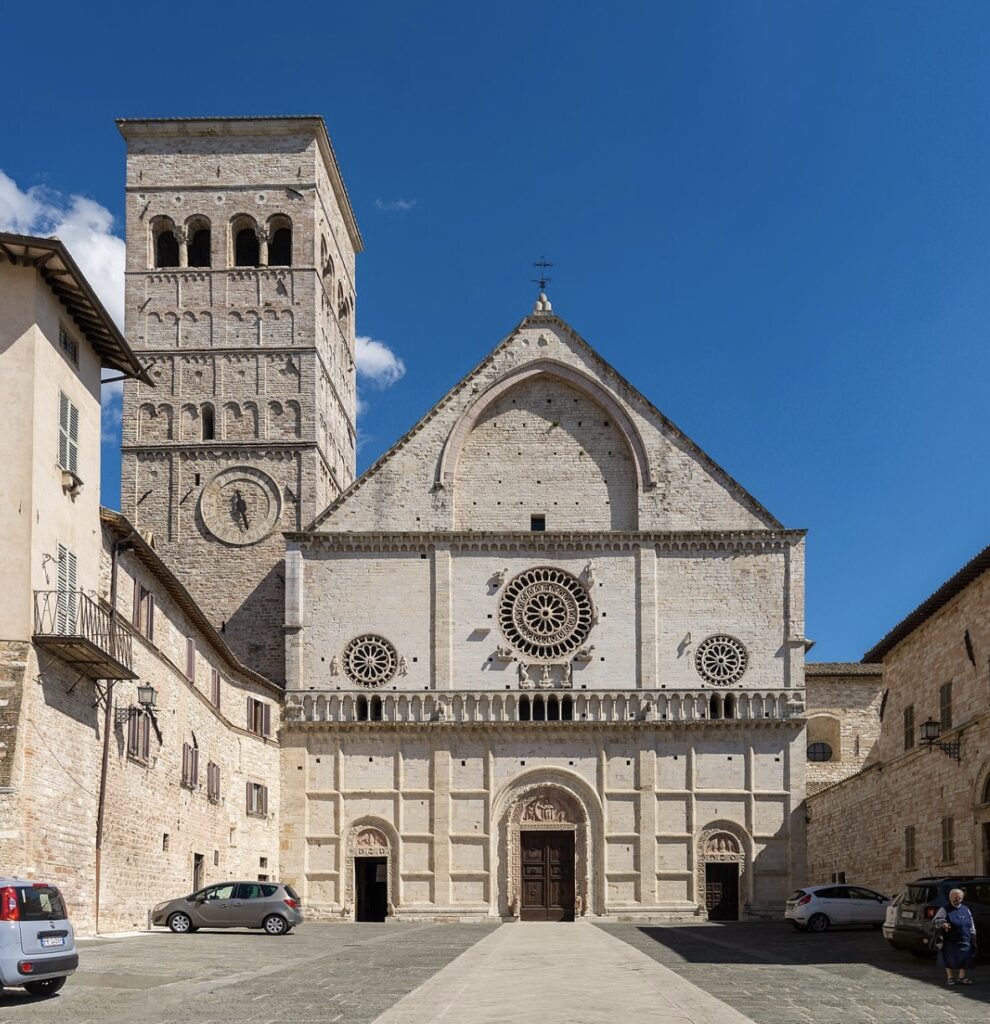
- Santa Maria degli Angeli (16th century):
- This basilica houses the Porziuncola, the small chapel where St. Francis founded the Franciscan Order. It is located in the plain below Assisi.
- Chiesa Nuova (17th century):
- Built on the site believed to be the birthplace of St. Francis, this church was constructed by the Spanish Viceroy of Naples in 1615.
- Basilica di Santa Maria degli Angeli (1569-1679):
- A large church enclosing the Porziuncola, an important site in the life of St. Francis.
- San Pietro (10th-12th centuries):
- A Romanesque church with notable architectural features and artworks.
- Palazzo dei Priori (13th-14th centuries):
- A medieval building that served as the town hall and now houses the municipal offices and art collections.
- Via San Francesco and Via Portica (Medieval streets):
- Historic streets lined with medieval buildings, shops, and cafes, offering a glimpse into the town’s past.
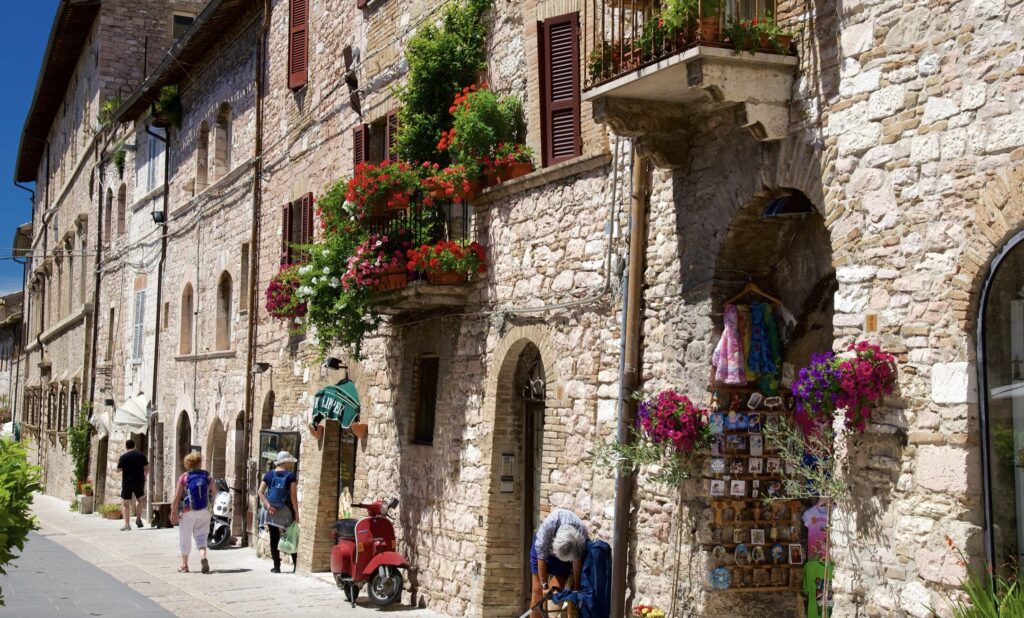
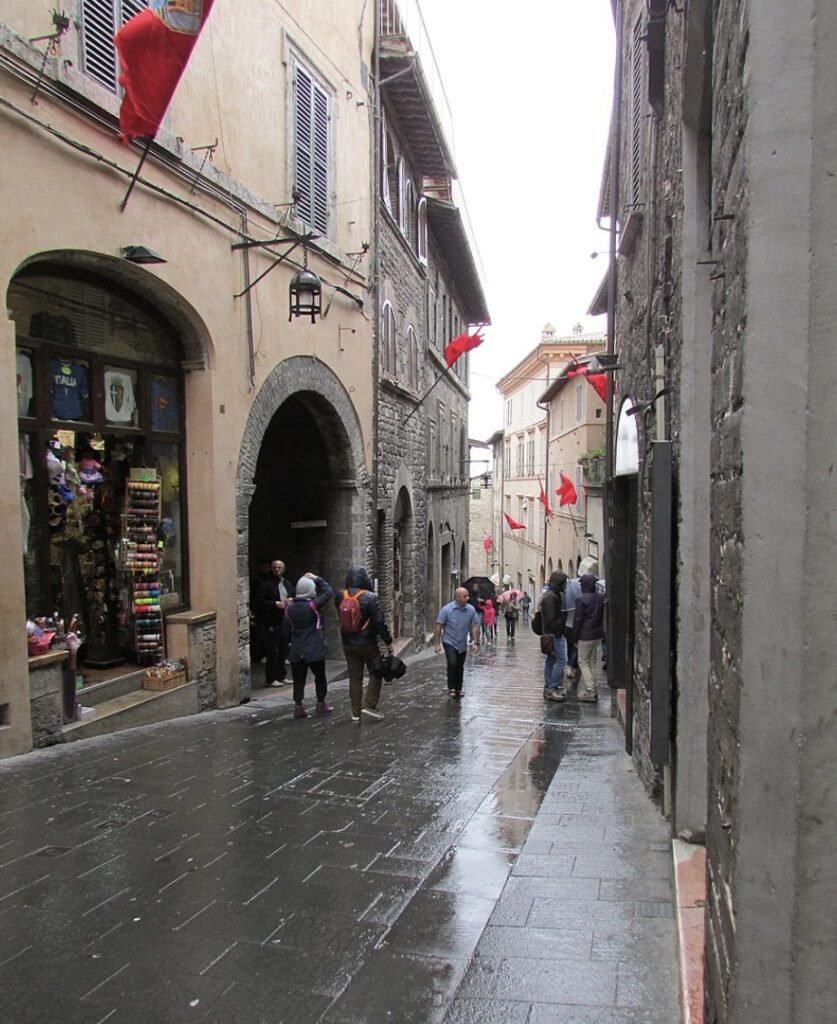
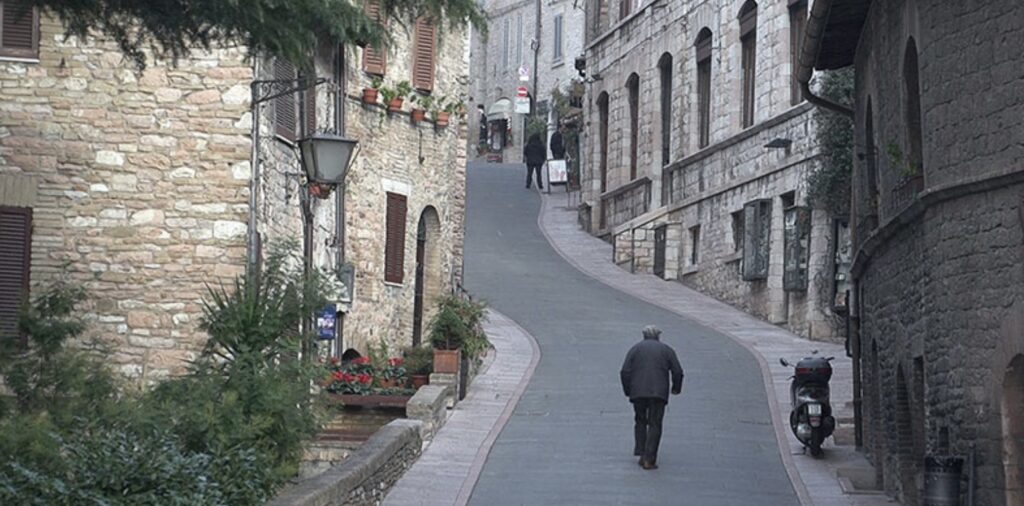
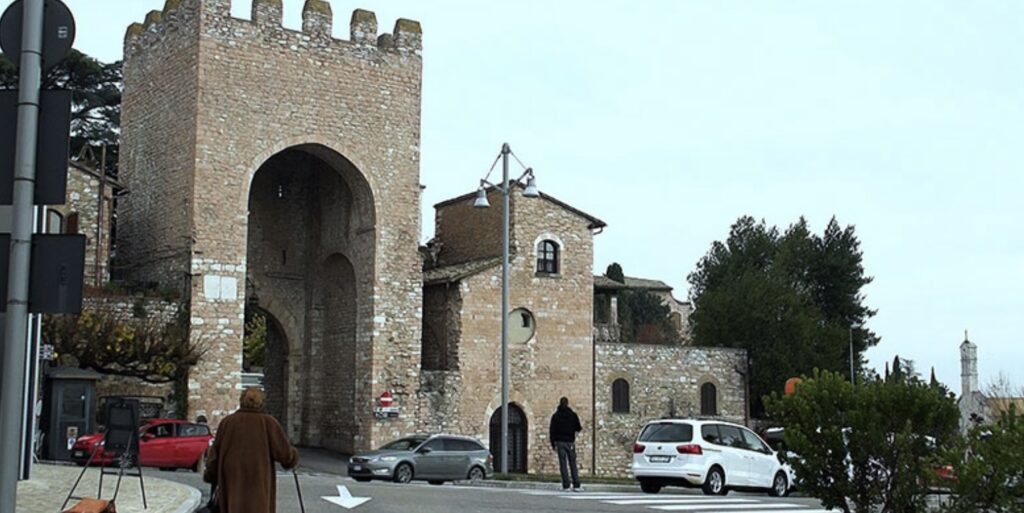
Assisi’s rich historical and cultural heritage is reflected in these monuments and attractions, making it a significant destination for both religious pilgrims and tourists interested in history and art.
Medieval architecture in Assisi is characterized by a blend of Romanesque and Gothic styles, reflecting the town’s historical and religious significance. Key features include:
Romanesque Features
- Thick Walls: Buildings often have thick, sturdy walls made from local stone, providing structural stability and defense.
- Round Arches: Romanesque architecture is distinguished by its use of rounded arches, particularly in doorways, windows, and arcades.
- Vaulted Ceilings: Barrel and groin vaults are common, creating spacious interiors that are both functional and visually impressive.
- Small Windows: Windows in Romanesque buildings are typically small and narrow, often with semi-circular tops, to maintain the structural integrity of thick walls.
- Symmetrical Layouts: Romanesque structures usually have a symmetrical and balanced layout, emphasizing order and solidity.
Gothic Features
- Pointed Arches: Gothic architecture introduced pointed arches, which allowed for higher and more flexible structures.
- Ribbed Vaults: Ribbed vaulting became prevalent, supporting more complex and elevated ceiling designs.
- Large Windows and Stained Glass: Gothic buildings feature larger windows, often filled with intricate stained glass that enhances interior lighting and religious storytelling through vivid imagery.
- Flying Buttresses: These external supports enabled the construction of higher walls and larger windows, distributing the weight and adding to the aesthetic appeal.
- Vertical Emphasis: Gothic architecture focuses on height and verticality, drawing the eye upwards towards the heavens, symbolizing divine aspiration.
Specific Examples in Assisi
- Basilica of San Francesco d’Assisi:
- Romanesque Lower Basilica: Characterized by its robust structure, rounded arches, and barrel vaults.
- Gothic Upper Basilica: Features pointed arches, ribbed vaults, and large stained glass windows, creating a sense of height and lightness.
- Basilica of Santa Chiara:
- A blend of Romanesque and Gothic styles, with a simple, solid structure complemented by Gothic pointed arches and a rose window.
- Cathedral of San Rufino:
- Romanesque Facade: With its strong, geometric forms, round arches, and small windows.
- Gothic Interior: Featuring ribbed vaults and larger windows.
- Rocca Maggiore:
- A medieval fortress with Romanesque elements, such as thick walls and rounded arches, designed for defense and durability.
- San Damiano:
- A Romanesque church with a simple, austere design, featuring rounded arches and a small, intimate interior space.
General Characteristics
- Stone Construction: The extensive use of local limestone and other stones contributes to the durability and cohesive aesthetic of Assisi’s medieval architecture.
- Fortified Structures: Many buildings, including churches and monasteries, have fortified elements reflecting the need for defense during turbulent times.
- Narrow Streets and Compact Layouts: The town’s medieval streets are narrow and winding, with buildings closely packed together, creating a sense of intimacy and protection.
- Monastic Influence: The presence of numerous monasteries and religious buildings influenced the architectural style, emphasizing simplicity, functionality, and spiritual symbolism.
The medieval architecture of Assisi embodies a rich blend of structural ingenuity, artistic expression, and spiritual significance, creating a unique and enduring historical landscape.
Here’s a two-day itinerary for visiting Assisi, including luxurious accommodation with historical features:
Accommodation
Nun Assisi Relais & Spa Museum:
- Description: This luxurious hotel is housed in a beautifully restored 13th-century monastery. It combines modern amenities with historical charm, offering an exceptional stay with a spa featuring Roman baths and a museum showcasing ancient artifacts.
- Location: Located in the heart of Assisi, within walking distance to major attractions.
Day 1: Historical Sites and Local Cuisine
Morning:
- Basilica of San Francesco d’Assisi:
- Time: 9:00 AM – 11:00 AM
- Activity: Explore the Upper and Lower Basilicas, admire the frescoes, and visit the tomb of St. Francis.
- Piazza del Comune:
- Time: 11:15 AM – 12:00 PM
- Activity: Stroll around the central square, visit the Temple of Minerva, and take in the medieval architecture.
Lunch:
- Local Restaurant:
- Time: 12:15 PM – 1:30 PM
- Suggestion: Trattoria Pallotta for traditional Umbrian dishes like truffle pasta or wild boar stew.
Afternoon:
- Basilica of Santa Chiara:
- Time: 1:45 PM – 2:45 PM
- Activity: Visit the church, see the tomb of St. Clare, and the famous Crucifix of San Damiano.
- Cathedral of San Rufino:
- Time: 3:00 PM – 4:00 PM
- Activity: Explore the Romanesque façade and interior, and learn about its historical significance.
Evening:
- Rocca Maggiore:
- Time: 4:15 PM – 6:00 PM
- Activity: Visit the medieval fortress, enjoy panoramic views of Assisi and the surrounding countryside.
Dinner:
- Local Restaurant:
- Time: 7:00 PM – 9:00 PM
- Suggestion: Osteria Pozzo della Mensa, known for its local cuisine and cozy atmosphere. Try the local wines and Umbrian specialties.
Day 2: Spiritual Sites, Nature, and Relaxation
Morning:
- San Damiano:
- Time: 9:00 AM – 10:30 AM
- Activity: Visit the church where St. Francis received his calling, enjoy the serene atmosphere.
- Eremo delle Carceri:
- Time: 11:00 AM – 12:30 PM
- Activity: Drive to this peaceful hermitage on Mount Subasio, explore the hermitage and surrounding nature trails.
Lunch:
- Picnic or Local Eatery:
- Time: 1:00 PM – 2:00 PM
- Suggestion: Bring a picnic to enjoy the natural surroundings or visit a local eatery like Ristorante degli Orti, which offers beautiful views and traditional dishes.
Afternoon:
- Santa Maria degli Angeli:
- Time: 2:30 PM – 4:00 PM
- Activity: Visit the basilica that houses the Porziuncola, the small chapel significant to St. Francis.
- Chiesa Nuova:
- Time: 4:30 PM – 5:15 PM
- Activity: Explore the church built on the site believed to be the birthplace of St. Francis.
Evening:
- Shopping and Leisure:
- Time: 5:30 PM – 7:00 PM
- Activity: Walk through the medieval streets, shop for local crafts, and enjoy the ambiance of Assisi.
Dinner:
- Local Restaurant:
- Time: 7:30 PM – 9:00 PM
- Suggestion: Ristorante La Fortezza, offering a mix of traditional and contemporary Umbrian cuisine.
Relaxation and Historical Immersion
- Spa and Wellness: After a day of sightseeing, unwind at the Nun Assisi Relais & Spa Museum, enjoying the Roman baths and spa treatments that integrate the historical ambiance with modern luxury.
Additional Tips:
- Local Specialties: Try local foods such as bruschetta with olive oil, Umbrian truffles, porchetta, and traditional desserts like rocciata.
- Wine: Enjoy local wines from the region, particularly the white wines of Assisi DOC.
- Guided Tours: Consider hiring a local guide for in-depth historical insights at major sites.
This itinerary provides a luxurious yet immersive experience in Assisi, combining historical exploration with relaxation and fine dining.
